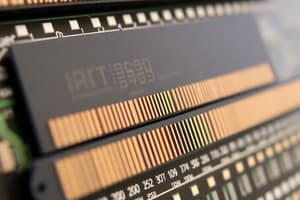Podcast
Questions and Answers
Consider a system employing a three-level cache hierarchy (L1, L2, L3) with inclusive properties. If the global miss rate observed at the L3 cache is 5%, and given that the local miss rates for L1 and L2 caches are 40% and 20% respectively, what is the closest approximate global miss rate for the L2 cache?
Consider a system employing a three-level cache hierarchy (L1, L2, L3) with inclusive properties. If the global miss rate observed at the L3 cache is 5%, and given that the local miss rates for L1 and L2 caches are 40% and 20% respectively, what is the closest approximate global miss rate for the L2 cache?
- 5%
- 8% (correct)
- 10%
- 2%
A cache system uses a 16-way set-associative mapping with a cache size of 64KB and a block size of 64 bytes. If the physical address space is 32 bits, what are the sizes of the tag, set index, and block offset fields, respectively?
A cache system uses a 16-way set-associative mapping with a cache size of 64KB and a block size of 64 bytes. If the physical address space is 32 bits, what are the sizes of the tag, set index, and block offset fields, respectively?
- 17 bits, 7 bits, 6 bits (correct)
- 15 bits, 9 bits, 8 bits
- 18 bits, 6 bits, 8 bits
- 16 bits, 8 bits, 8 bits
Consider a memory system employing a write-back cache policy. Which of the following scenarios would necessitate a write-back operation to main memory?
Consider a memory system employing a write-back cache policy. Which of the following scenarios would necessitate a write-back operation to main memory?
- A cache block in the 'dirty' state is selected for replacement due to a cache miss. (correct)
- A cache miss occurs, and the replacement policy evicts a 'clean' block to make space for the newly fetched block.
- A cache hit occurs on a 'dirty' block, and the CPU modifies the data within the block.
- A cache block is invalidated due to an external snoop request while it is in the 'clean' state.
In the context of cache coherence protocols for multi-processor systems, which of the following describes the purpose of 'snooping'?
In the context of cache coherence protocols for multi-processor systems, which of the following describes the purpose of 'snooping'?
Given a DRAM chip organized as 4K x 8 bits, how many such chips are required to construct a 128KB memory?
Given a DRAM chip organized as 4K x 8 bits, how many such chips are required to construct a 128KB memory?
In the context of memory technology, what distinguishes Spin-Transfer Torque RAM (STT-RAM) from other non-volatile memory types?
In the context of memory technology, what distinguishes Spin-Transfer Torque RAM (STT-RAM) from other non-volatile memory types?
Consider a system that uses a virtually addressed cache with a write-through policy. What is the primary challenge that must be addressed to maintain cache coherence in this architecture?
Consider a system that uses a virtually addressed cache with a write-through policy. What is the primary challenge that must be addressed to maintain cache coherence in this architecture?
A processor has a two-level cache hierarchy with the following characteristics: L1 cache access time is 1 ns, L2 cache access time is 10 ns, L1 cache hit rate is 95%, and the global hit rate (including both L1 and L2) is 99%. What is the effective memory access time?
A processor has a two-level cache hierarchy with the following characteristics: L1 cache access time is 1 ns, L2 cache access time is 10 ns, L1 cache hit rate is 95%, and the global hit rate (including both L1 and L2) is 99%. What is the effective memory access time?
In the context of cache design, what is 'cache pollution,' and which strategy is most effective in mitigating it?
In the context of cache design, what is 'cache pollution,' and which strategy is most effective in mitigating it?
Consider a system using ReRAM (Resistive Random-Access Memory). What fundamental physical phenomenon underlies ReRAM's ability to store data?
Consider a system using ReRAM (Resistive Random-Access Memory). What fundamental physical phenomenon underlies ReRAM's ability to store data?
A memory system uses a two-level page table scheme with a 4KB page size and 4-byte page table entries. If the virtual address space is 48 bits, what is the size of each page table (in bytes)?
A memory system uses a two-level page table scheme with a 4KB page size and 4-byte page table entries. If the virtual address space is 48 bits, what is the size of each page table (in bytes)?
In a system with a write-invalidate cache coherence protocol, what is the principal consequence of a processor writing to a shared cache line?
In a system with a write-invalidate cache coherence protocol, what is the principal consequence of a processor writing to a shared cache line?
What is the fundamental difference between EPROM and EEPROM concerning how their memory cells are erased?
What is the fundamental difference between EPROM and EEPROM concerning how their memory cells are erased?
Consider a processor implementing a non-blocking cache. What architectural feature is essential to prevent the processor from stalling during a cache miss?
Consider a processor implementing a non-blocking cache. What architectural feature is essential to prevent the processor from stalling during a cache miss?
Given a fully associative cache with 128 blocks and a block size of 32 bytes, what is the principal advantage of using a Least Recently Used (LRU) replacement policy compared to a First-In-First-Out (FIFO) policy?
Given a fully associative cache with 128 blocks and a block size of 32 bytes, what is the principal advantage of using a Least Recently Used (LRU) replacement policy compared to a First-In-First-Out (FIFO) policy?
In the context of memory address mapping techniques, what is the primary disadvantage of direct mapping compared to set-associative mapping?
In the context of memory address mapping techniques, what is the primary disadvantage of direct mapping compared to set-associative mapping?
Consider a cache system employing a write-back, write-allocate policy. If a cache miss occurs during a write operation, what sequence of actions is initiated?
Consider a cache system employing a write-back, write-allocate policy. If a cache miss occurs during a write operation, what sequence of actions is initiated?
How does increasing the associativity of a cache typically impact its power consumption, and what is the underlying reason for this change?
How does increasing the associativity of a cache typically impact its power consumption, and what is the underlying reason for this change?
Which of the following coherence protocol states typically indicates that a cache line contains the most up-to-date copy of the data and no other cache has a copy of this line?
Which of the following coherence protocol states typically indicates that a cache line contains the most up-to-date copy of the data and no other cache has a copy of this line?
Flashcards
Cache Memory
Cache Memory
Fast, expensive memory that CPU accesses directly; Level 1, Level 2, and Level 3.
Principle of Locality
Principle of Locality
The principle stating that memory accesses tend to cluster in specific areas.
Cache Mapping Techniques
Cache Mapping Techniques
Direct, Associative, and Set-Associative Methods to decide where to keep copies of data in cache.
Cache Hit Rate
Cache Hit Rate
Signup and view all the flashcards
Miss Penalty
Miss Penalty
Signup and view all the flashcards
Cache Coherence
Cache Coherence
Signup and view all the flashcards
Cache Write Policy
Cache Write Policy
Signup and view all the flashcards
Associative Memory
Associative Memory
Signup and view all the flashcards
Volatile Memory
Volatile Memory
Signup and view all the flashcards
RAM
RAM
Signup and view all the flashcards
Dynamic RAM (DRAM)
Dynamic RAM (DRAM)
Signup and view all the flashcards
Static RAM (SRAM)
Static RAM (SRAM)
Signup and view all the flashcards
ROM
ROM
Signup and view all the flashcards
EPROM
EPROM
Signup and view all the flashcards
EEPROM
EEPROM
Signup and view all the flashcards
Secondary Memory
Secondary Memory
Signup and view all the flashcards
ReRAM, PCM, STTRAM
ReRAM, PCM, STTRAM
Signup and view all the flashcards
Study Notes
- Memory hierarchy involves different types of memory organized by speed and cost.
Primary Memory
- Primary memory includes RAM (Static and Dynamic) and ROM (EPROM, EEPROM).
- It also includes Cache memory at levels 1, 2, and 3.
Secondary/Auxiliary Memory
- Secondary memory includes Magnetic Disks.
Emerging Memory Technologies
- ReRAM, PCM, and STTRAM are examples of emerging in-situ memory technologies.
Main Memory
- Main memory consists of RAM and ROM chips.
- Memory Address Map is crucial for locating data.
- Memory connects to the CPU for data transfer.
Associative Memory
- Associative memory allows content-based retrieval.
Cache Memory
- Principle of Locality is fundamental to cache memory, where frequently accessed data is stored for faster retrieval.
- Cache mapping techniques determine how memory blocks are mapped in the cache.
- Hit Rate and Miss Penalty are key performance considerations.
- Cache coherence ensures data consistency across multiple caches.
- Cache read and write policies manage how data is read from and written to the cache.
- Caches are integrated on the Processor Chip to reduce access time.
Studying That Suits You
Use AI to generate personalized quizzes and flashcards to suit your learning preferences.




